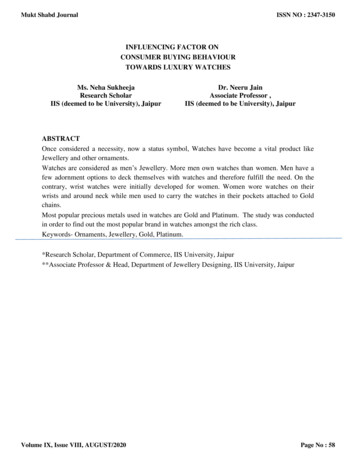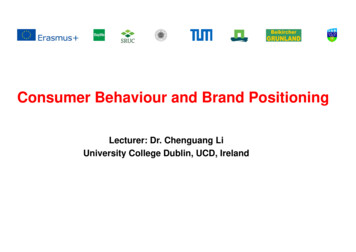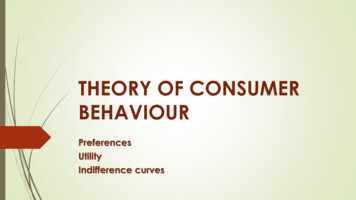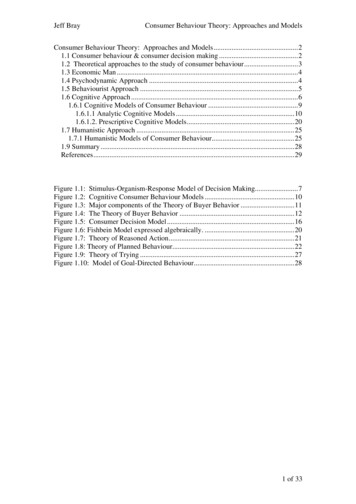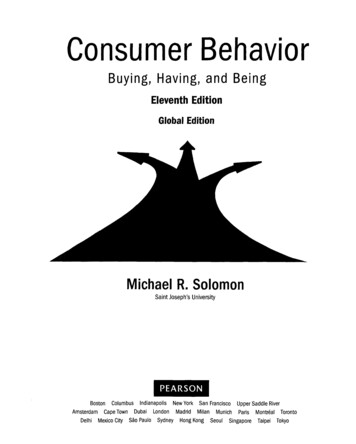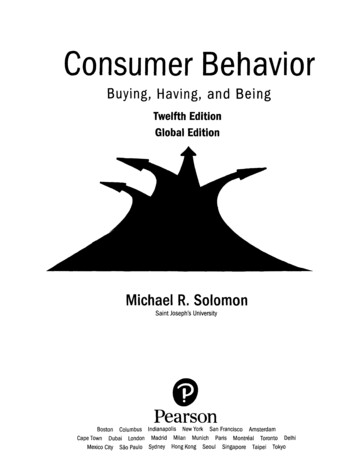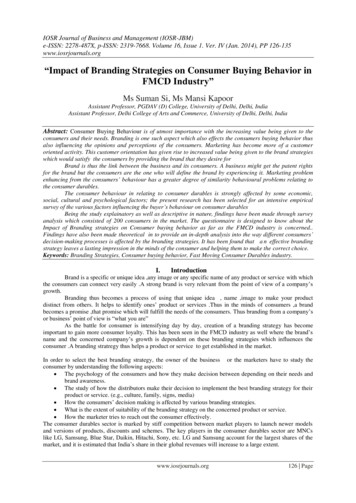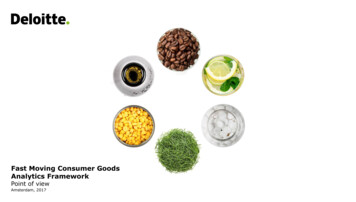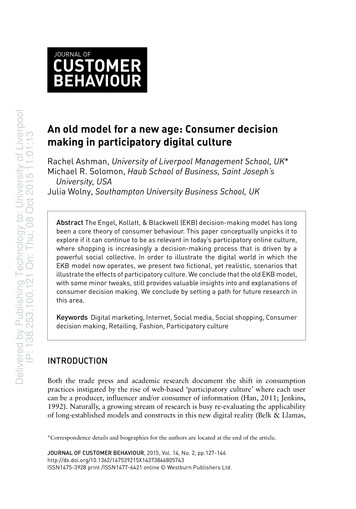
Transcription
IOSR Journal of Business and Management (IOSR-JBM)e-ISSN: 2278-487X, p-ISSN: 2319-7668. Volume 19, Issue 11. Ver.III (November. 2017), PP 54-59www.iosrjournals.orgConsumer Buying Behaviour towards Fast Moving ConsumerGoods(A Study of Selected Personal Care Products in NizamabadDistrict of Telangana State)*Dr. Rambabu Gopisetti ,**G.Linganna.* Chairman, Board Of Studies, Department of Commerce, Telangana University, Dichpally, Nizamabad Districtof Telangana State,503322.** Asst.Professor of Commerce, Govt. Degree College,Bodhan,503185 and The Research Scholar, Dept.ofCommerce , Telangana University, Dichpally, Nizamabad of Telangana State, 503322.Corresponding Author: *Dr. Rambabu GopisettiAbstract: Fast Moving Consumer Goods (FMCGs) constitute a large part of consumer s budget in allcountries. India is no exception to this. The Consumer Buying Behaviour plays an important role in marketingof Fast Moving Consumer Goods. Keeping in view the frame of references the present paper is an attempt tostudy the factors affecting the Consumer Buying Behaviour towards selected Personal Care Products. Because,of these factors, the FMCG market in India is expected to grow from US 30 billion in 2011 to US 74 billion in2018. Hence, the buying behaviour of consumer has become a good topic for discussion. For this study theprimary data has collected from 200 respondents of Nizamabad District with structured questionnaires. Thesecondary data has been collected from various Books, Journals, Articles and Websites. In this regardsTelevision, Quality and Brand loyalty are the powerful factors to influence the consumer buying behaviour.Television is the powerful tool for spreading the information of brands to the final consumers.Keywords: FMCG, Personal Care Products, Consumer Buying Behaviour, ------------------------------------ ---------Date of Submission: 07-11-2017Date of acceptance: ----------------------------------- ----------I. Introduction to Conceptual frame workConsumer is one who consumes the goods & services product. The aim of marketing is to meet andsatisfy target Consumer needs and wants. The modern marketing concept makes customers the centre stage oforganisation efforts. The focus, within the marketing concepts is to reach target and largest customer’s sets ballrolling for analysing each of the conditions of the target market 1. Consumer behaviour can be defined as thedecision making process and physical activity involved in acquiring, evaluating, using and disposing of goodsand services. This definition clearly brings out it is not just the buying of goods / services that receives attentionin consumer behaviour, but the process starts much before the goods have been acquired or bought. The studyConsumer Buying Behaviour is the study of how individuals make decisions to spend their available resources(time, effort, money) on consumption related item. It includes the study of what they buy it, where they buy it,how they buy it and how often they use it. It is important to know how consumer reacts towards differentproducts. Buying behaviour involves a complicated series of stimulus and response 2.Fast Moving Consumer Goods (FMCG) are popularly known as Consumer Packaged Goods. Items inthis category include all consumables, people buy at regular intervals. The most common Personal CareProducts are Shampoos, Hair oil, Bathing soaps, Toothpaste, Cosmetics etc. These items are meant for daily offrequent consumption3.Top 10 Companies of FMCG sector in India according to their Revenues and Incomes.1. Indian Tobacco Company (ITC)2. Hindustan Unilever Ltd. (HUL)3. Brittania Industries Ltd.4. Nestle India5. Dabur India Ltd.6. Marico Ltd.7. Patanjali Ayurved8. Godrej Consumer Products Ltd.(GCPL)DOI: 10.9790/487X-1911035459www.iosrjournals.org54 Page
Consumer Buying Behaviour Towards Fast Moving Consumer Goods.9. GlaxoSmithLine10. Colgate-Palmolive Ltd.(Source: Wikipedia)Objectives of the StudyThe main objective of the study is that, which factors influencing on consumer buying behaviourtowards selected Personal Care Products in Nizamabad District and following are the sub objectives of thestudy.1. To present the Demographic and Socio economic profile of the Sample Respondants of Nizamabad District.2. To study the consumer brand preference towards Personal Care Products in Nizamabad District.3. To analyse the factors, this influenced the consumer buying behaviour towards Personal Care Products inNizamabad District.4. To know the level of satisfaction towards Personal Care Products in Nizamabad District.Research MethodologyThe present study was undertaken to understand the buying behaviour of the consumers towardsselected Personal Care Products and to know the factors which influences the buying behaviour and how thesefactors play an important role in buying decision. The data required for the study were collected from the samplerespondents of Nizamabad District of Telangana state by personal interview method using well structuredquestionnaire. The total sample selected 200 which influenced the urban and rural consumers. The majorinformation was collected from primary data and secondary sources of information were collected from variousbooks, records, annual reports, other publications and websites wherever required. The data gathered has beenprocessed and tabulated by using M.S.Excel software and in part manually. Simple statistical tools have beenused for analyse the data.Need for the StudyThe Personal Care Products in FMCG sector shows tremendous growth in last few years compares toother sectors, investors to make their investment in his sector only. However there is high growth tendency forPersonal Care Products in FMCG sector, it faces some difficulties in achieving their destination. Hence, thepurpose of this study is to identify the force that influences on consumer shopping pattern particularly inNizamabad District.Sampling DesignFor this study Convenient Sampling method was used. This study conducted in various places inNizamabad District and as the population is very high the researcher couldn t conduct a census study, due totime constraint Convenient Sample was followed.Review of LiteratureThe study focused on gaining insight in to the influence of various factors on the purchase behaviour ofrural consumers. The factors included were related to the personal care brands and rural consumers. The studydid not take into consideration about the influence of advertising and other promotional factors. From the studyit is evident that quality of personal care brands were given more emphasis and the difference in educationallevel of respondents is significant in case of certain factors namely quality, nearness to selling point and retailer.With increased education the rational thinking of rural consumers is improved and impulse the buying isreduced. They make more rational decisions even though they belong to the rural regions. Income had asignificant difference across marital status and gender respondents in influencing their purchase decision.Majority of the consumers do not mind visiting towns to purchase good quality brands of personal careproducts. Further, the marketers must constantly monitor the rural consumer purchase behaviour through localretailers and seek their assistance in curbing fake brands4.As indicated by this research, Indian consumers and shoppers in the hair care market experienceinfluence from various factors. These sources of influence, if properly managed by the marketers of hair careproducts, act as facilitators for sellers during the marketing and selling process. For instance, brand that havebeen in the market since long, such as HUL and P&G, can leverage the trust worthiness of their lineage to affectthe buyers behaviour at the time of decision making and purchase. Similarly, parameters such as wuality can bestressed upon in marketing communications and testimonials on social platforms to positively the consumersbuying behaviour5.DOI: 10.9790/487X-1911035459www.iosrjournals.org55 Page
Consumer Buying Behaviour Towards Fast Moving Consumer Goods.Any nation economic development is based on those Nations natural resources, efficient humanresources and appropriate utilization of such resources. There is no doubt about it that rural market has highpotential for introducing new non-durable products for new entrants in the rural markets. At last, it can besuggested to all the marketers “Go Rural” because there is lot potential for marketing of products 6.It is found that rural buyers perceived that TV commercials followed by print advertisements and wordof mouth plays a significant role for taking the decision to purchase these FMCGs. Further, they consider theirown experience, display at shops, incentive schemes for the purchase of these FMCGs, where they do not fullyagree that advice of beautician influences their decision towards the purchase of these FMCGs. Therefore, itmay be recommended that the producers or marketers should frame ethical advertising strategies keeping inmind that rural people are fond of electronic and print media advertisements7.4. P.Prialatha andDr.K.Malar Mathi, “a Case study on factors influencing rural consumer buying behaviourtowards personal care products in Coimbatore district” Vol:2 Issue 9,September//2011// ISSN 0976-2183.5. Ms.Rashmi,”study of buying behaviour of Indian consumers in the hair care product market”, scholar’sworld-IRMJCR, Vol: 1, Issue 3.November//2013// ISSN 2320-3145.6. Dr.Rambabu Gopisetti and Dr.T.Satyanarayana Chary,”consumer brand preference towards non-durableproducts in rural markets (a study of selected villages in Nizamabad district of Andhra Pradesh).7. Dr.Surender singh kundu,”customer perception towards the fast moving consumer goods in rural market: ananalysis”, IJTMR, Vol: 1, Isssue 2, September//2013//ISSN 2321-3744.Table: 1Demographic and Socio-Economic profile of the sample RespondentsProfileAgeFrequencyPercentagesBelow 20 years603021 to 40 years41-60 years61 and ol levelInterUnder GraduationPost 02806341410100151033191310100Marital StatusSocial CategoryIncomeEducationOccupation(Source: Primary Data)Demographic & Socio- Economic profile of the sample respondents are presented in the above table-1,it is inferred that among the 200 respondents 66 percent Married and remaining 34 percent Un-married. Anattempt has also been made on the basis of consumer age group 44 percent respondents from 21 to 40age groupand followed by below 20 years age group stands at 30percentage 41 to 60 years and 61& above age group are20&06 percents only. It reflecting up to 40 years age group i.e. 74 percent is using the personal care products.DOI: 10.9790/487X-1911035459www.iosrjournals.org56 Page
Consumer Buying Behaviour Towards Fast Moving Consumer Goods.Most of the sample respondents belong to BC category representing 48 percent followed by OC membersstanding at 22 percent. SC&ST category representation stands at only 18 and 12 percent respectively. It can beinferred that OBC category dominates the composition of overall consumers in district. Among the totalrespondents 46 percent are drawn from Middle Income Groups (MIG) and 32 percent representing LowerIncome Groups (LIG), where as Higher Income Groups (HIG) stood at 22 percent. The participation of theconsumers including MIGs and LIGs represents near about 78 percent and it is reflecting only MIGs and LIGspeoples are more when compare with HIGs in the district. On the basis of their education levels about 34percent of the sample respondents had completed Under Graduation and 28 percent had completed SecondaryEducation, Post Graduation and others are representing at 14&10 percent. Only 8 percent were Illiterates. About32 percent of sample respondents were representing as Employees in both private as well as public sectors, 20percent belongs to Business and 15 percent stands for Agriculture, 13 percent indicates as Students. BothLabour and others are jointly representing 12 and 10 percent respectively. It can be said the consumers wereengage.Table-2Brands used for Personal Care ProductsPersonal Care ProductsShampooHair OilTooth pastePersonal Care ProductsBathing soapCosmeticsName of the brandClinic me of the brandSantoorCintholMedimixLifebouyLuxRexonaMysore SandalPathanjaliOthersTOTALLakmeL Oreal ParisViccoPondsFair&LovelyFair everFair & 00180410301208080406100(Source: Primary data)DOI: 10.9790/487X-1911035459www.iosrjournals.org57 Page
Consumer Buying Behaviour Towards Fast Moving Consumer Goods.In the present study, Personal Care Products are taken as follows, Shampoo, Hair oil, Tooth paste,Bathing soap and Cosmetics. Table-2 presents the details about the brands used by the consumers. RegardingShampoo, Sunsilk and Head&Shoulder are popular brands used by the respondents; its equal represents at 18percent and followed by Meera and Clinicplus stands at equal 14 percent. It is clear that Pantene and Pathanjaliare sharing equally represents each 10 percent, Chik and other shampoos are are represents at 4 and 2 percentrespectively. It can be said that, Sunsilk and Head&Shoulder are popular brands in the FMCG market because,of their extensive and effective advertisements. From the same table Chik shampoo is not well in the minds ofthe consumers. In case of Hair oil, Parachute is very popular brand used by the consumers represents 48 percentfollowed by Vatika stands at 12 percent. Ashwini, Meera and Pathanjali are sharing equally represents each 10percent. SESA and other Hair oils are represents equally at 3 percent. Samvridhi brand is not used by singlerespondent.Colgate tooth paste is a popular brand represents 38 percent and followedby Close-up stands at 30percent, Pathanjali and Pepsodent represents 12 and 10 percent respectively Colgate is popular brand because ofstrong brand loyalty due to effective advertisements.In case of Bathing soap, Santoor is a powerfull brand usedby the consumer’s represents 28 percent and followed by Cinthol stands at 25 percent and next followed brandRexona stands at 12 percent, Lux and Pathanjali equally represents each at 10 percent. Santoor is very powerfulbrand due effective advertisements.In view of the Cosmetics, Ponds is a popular brand in the minds of consumers represents at 30 percentand followed by Lakme stands at18 percent. All the consumers are using popular brands in the Cosmetics. Byand large all the consumers prefer branded products for their frequent use; this may be due to increasing literacylevels and communication technologies in the district.Table-3Factors influenced on buying behaviour of sample respondents towards Personal Care ProductsFactorsHigh influencedModerate influencedCultureQuantityPriceTrialReference GroupBrandsTelevisionNews PaperDisplay at shopWordIncentives 20(10)02(01)44(22)40(20)(Source: Primary data, and figures in brackets shows percentages)In the above table-3 ,Television is the most powerful factor influenced the consumer buying behaviourwith represents at 88 percent and followed by Quality and Brand loyalty stands at82 & 80percent respectively,next powerful factors are Income and News paper which represents at 68 &62 percent. In case of Culture is thelowest influence factor at 38 percent and followed by Labelling and Age factors at 22 and 19 percent. Thus, aconclusion is possible here that, Television is the most powerful factor which influenced the buying behaviourof consumers and followed by Quality and Brand loyalty factors. New entrants in to the FMCG markets canselect the Television to create Brand awareness among the consumers with Quality product.Table-4Level of Satisfaction towards Personal Care ProductsProductsShampooHair OilTooth pasteBathing soapCosmeticsHigh satisfied84(42)136(68)96(48)124(62)90(45)Moderate satisfied64(32)56(28)76(38)56(28)70(35)Low satisfied32(16)08(04)28(14)20(10)40(20)(Source: Primary data, and figures in brackets shows percentages)DOI: 10.9790/487X-1911035459www.iosrjournals.org58 Page
Consumer Buying Behaviour Towards Fast Moving Consumer Goods.The above table-4 indicates that, at 68 percent consumer highly satisfied with their used brands of Hairoil and followed Bathing soap at 62 percent, at 20 percent low satisfied with their used brands of Cosmetics andfollowed by Tooth paste stands at 14 percent.Findings OBC category dominates the composition of the overall respondents. It reflecting up to the 40 years of age they are much concentrating on personal care products. Regarding the brands, Sunsilk and Head & Shoulder in shampoo Parachute in hair oil, Colgate in toothpaste, Santoor in bathing soap and Ponds in cosmetics are more powerful brands in personal care products. Because of their extensive and effective advertisement campaigns and all consumers prefer brandedproducts for their frequent use; this may be indication of increasing literacy and improving communicationtechnologies. Television is the powerful factor which influenced the buying behaviour of consumers and followed byQuality and Brand loyalty. New entrants in the FMCG market can select Television to create brand awareness among the consumerand maintain with Quality product. The consumers were high satisfied with their used brands of Hair oil and followed by bathing soap. Lowsatisfied with their used brands of Cosmetics.II. ConclusionThe study focused on gaining insight into the influence of various factors on the buying behaviour ofconsumers towards personal care products, it is found that consumers perceived that Television commercialsand followed by Quality and Brand loyalty are significant factors which more influences on the consumerbuying behaviour even though they are middle income groups and lower income groups. With increasededucation and below the 40 years age respondents are more using the personal care products. Further, theyconsider reach the branded products to the final consumers use the print media and incentive schemes. There, itmay be recommended that the marketers must constantly monitor the final consumers and to use the electronicmedia i.e. T.V. print media i.e. news paper to create awareness of their brands among the final consumers withquality .[9].Geeta Sonkusare,”Impact of television advertising on buying behaviour of women consumers (with special reference to FMCGproducts”IJBMI,Volume 2 Issue 3//March//2013 pp 31-38.Dr. S. Mahlingam,” A Study on consumer behaviour towards selected fast moving consumer goods in Coimbatore city”,IJEIM,Vol:1Issue 11//November 2012//ISSN:2277-5374, PP 500-507.Dr.Vibuti,” A Case study on consumer buying behaviour towards selected FMCG products”IJS
Abstract: Fast Moving Consumer Goods (FMCGs) constitute a large part of consumer s budget in all countries. India is no exception to this. The Consumer Buying Behaviour plays an important role in marketing of Fast
